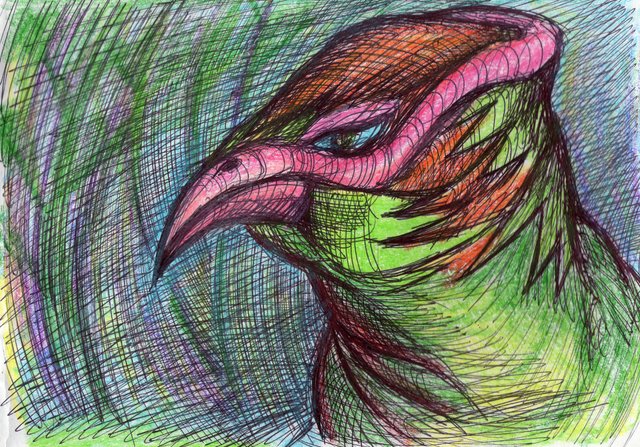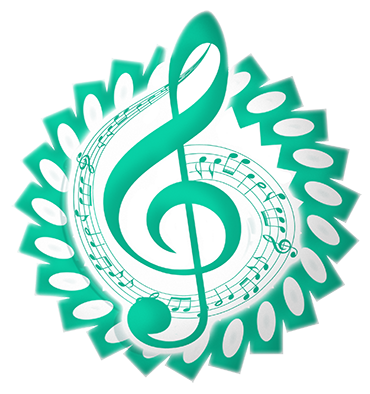Friday Music at Five Episode #2: HORUS (SONATA FOR KEYBOARD) - in g# minor | AsteriskedMusic.Com
Horus (Sonata for Keyboard) - in g# minor
This episode of Friday Music at Five features "The Proud Bird," by Roman Skvortsov. Roman goes by @romanskv here on Steemit. This is a depiction of the ancient Egyptian god of Horus. What grabbed my attention in this piece is the artist's choice to reimagine the ancient two-dimensional Egyptian images and render it in three dimensions with very interesting color choices for the shading. I also like the extreme colorfulness of the god and the proud, confident, intelligent expression on its face. The background is vague and dark, while the bird is colorful and highly distinct. The curve and sharpness of the beak, the haughty look in the bird's eye, the musculature of the face; all of these things suggest a masculine vitality, power, and fearlessness.

"The Proud Bird," by Romansk V., taken from [SteemIt.Com]; this image is used with the permission of its creator.
The Egyptian Renaissance
It has occurred to me that we may be on the verge of a renaissance of rediscovering the deep roots of the Abrahamic religions, which really do go back as far as Egypt; and even further, into the days of Hammurabi and Sumer. However, Egypt particularly is where many of the archetypical stories that are cherished by the Jews, Christians, and Muslims originate. It is also interesting that, according to legend, in the times of the sons of Noah, Egypt was the seat of authority for Shem; from which he exercised God's justice on Earth.
This is important because the Post-Modern Structuralist intellectual narrative has begun to unravel. People are seeking a new way of developing a relationship with being. Consequently, one of the most popular intellectuals of our time is Dr. Jordan Peterson, whose Biblical Lecture Series represents a deep dive into the intellectual roots of the Western Tradition and morality. Part of what led to the rejection and death of God in the nineteenth and twentieth centuries was an ossified understanding of this tradition.
The Christ Story of Horus
What better symbol for this rebirth of the Western Tradition than that of Horus, the ancient Egyptian christ figure. According to ancient Egyptian tradition, Osiris is murdered by his brother Set. Osiris's wife, however, reassembles the corpse of Osiris, engages in intercourse with it, and gives birth to Horus. Horus is regarded as the resurrected form of Osiris.
Horus, therefore, represents the divine masculine; that which overcomes death and destruction.
Some Notes on Horus (Sonata for Keyboard) - in g# minor
This piece expresses a major philosophical theme. That is, the backdrop to life is struggle and hardship. Death always lies in wait for us. However, we can overcome this. We are not linear creatures. We are creatures of light. Death, darkness, and hardship exist in order that the heroism of our being can shine against it like eternal stars in the night sky.
The harmonic trajectory of the piece is rising dominant-tonic resolutions. The first movement is in g# minor, which is a tumultuous key, to my ear. The second movement is in c# minor, which is the darkest key, to my ear. The final movement is in f# minor, which has a spiritual energeticness.
First Movement - Vivace
This movement is in a modified sonata form. This movement begins with a trill ostinato. The upper note of the ostinato traces a simple melodic line against the tonic bottom. This is the main theme. The countertheme is in the relative B Major. It is slower and melodic. The countertheme goes directly into a development section. The countermelody, rather than the main theme, is developed. In the recapitulation, the two themes are combined polyphonically and polytonally.
The modification of the form reflects three things. Firstly, the backdrop of life is death and struggle. Secondly, although that is the case, the contrasting, heroic living power is far more worthy of our attention and is what undergoes development in being. Finally, in the end, we live before death's face with courage, grace, and defiance, even as it pursues to end us.
Second Movement - Dirge
This is a funereal movement in ternary form. The general form of this movement is 'ABA,' where each section also undergoes a certain amount of thematic development. The first iteration of the 'A' section is an Adagio that expresses a quiet shock of loss. The first reaction to death is often not overwhelming emotion, but rather an inability to process the fact of loss. The 'B' section is a somewhat faster Allegretto, where one recalls the living force of the one lost. The return of the 'A' section is in a higher, less shocked and somber register. Here, the emotional outpouring of the loss comes into experience.
Third Movement - Allegro
This movement is in a truncated sonata form. The main theme is a defiant, aggressive, fearless birdsong. The counter theme is a much softer, melodic theme in the relative major. This theme undergoes some brief development on the way back to the recapitulation. The final section of the piece is simultaneously a development section and long, raucous, sped-up CODA dominated by a few variations of the main theme, ending in a brief recapitulation of the counter theme in the main key of f# minor.
Although the main key of this movement is in the minor, the main theme is extremely lively. This is done to suggest that, although the backdrop of life is struggle and death, in the end, the power of the divine masculine merely shines that much brighter against the dark.
Copyright, Philip John Cornell, 2018, some rights reserved. You may download this content freely. If you share it, it must be prominently attributed to "PJ Cornell," and if shared online, a link to the original content must be provided in a prominent location. This audio and video content may not be used for commercial purposes or modified in any way without permission from the copyright owner.
Only the latest episodes of this show are available on iTunes and Soundcloud. To locate archives of this podcast, visit: http://pjcornell.com/category/asterisked-music/piano-podcast
Follow me on Soundcloud: https://soundcloud.com/pj-cornell
Follow me on iTunes: (Asterisk Piano Podcast)
Follow me on Steemit: https://steemit.com/@pjcomposer
Join the conversation on my site: http://pjcornell.com
Resteemed, your post will appear in the next curation with a SBD/STEEM share for you!
Your post has been supported and upvoted from the Classical Music community on Steemit as it appears to be of interest to our community.
If you enjoy our support of the #classical-music community, please consider a small upvote to help grow the support account!
You can find details about us below.

The classical music community at #classical-music and Discord.
Follow our community accounts @classical-music and @classical-radio.
Follow our curation trail (classical-radio) at SteemAuto or help us out with a delegation!
Congratulations @pjcomposer! You have completed the following achievement on the Steem blockchain and have been rewarded with new badge(s) :
Click here to view your Board of Honor
If you no longer want to receive notifications, reply to this comment with the word
STOPTo support your work, I also upvoted your post!
Do not miss the last post from @steemitboard:
Hi @pjcomposer!
Your post was upvoted by @steem-ua, new Steem dApp, using UserAuthority for algorithmic post curation!
Your UA account score is currently 1.278 which ranks you at #43330 across all Steem accounts.
Your rank has dropped 48 places in the last three days (old rank 43282).
In our last Algorithmic Curation Round, consisting of 251 contributions, your post is ranked at #210.
Evaluation of your UA score:
Feel free to join our @steem-ua Discord server
Congratulations @pjcomposer! You have completed the following achievement on the Steem blockchain and have been rewarded with new badge(s) :
Click here to view your Board of Honor
If you no longer want to receive notifications, reply to this comment with the word
STOPDo not miss the last post from @steemitboard: